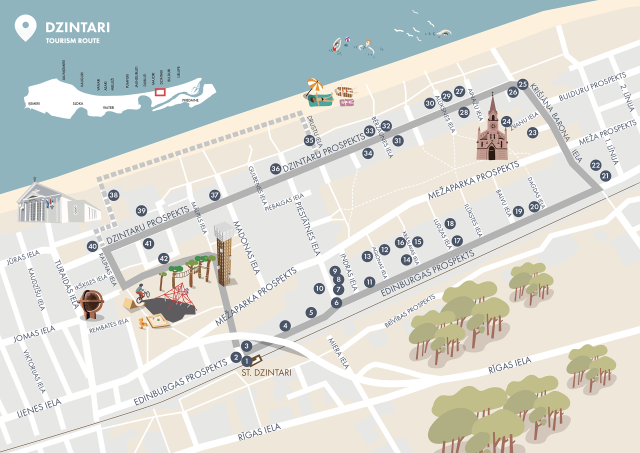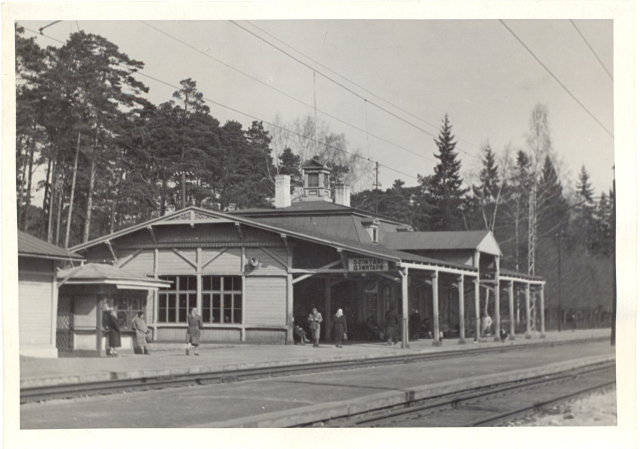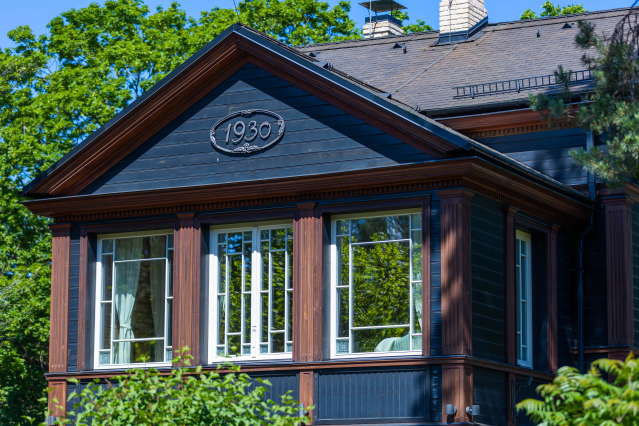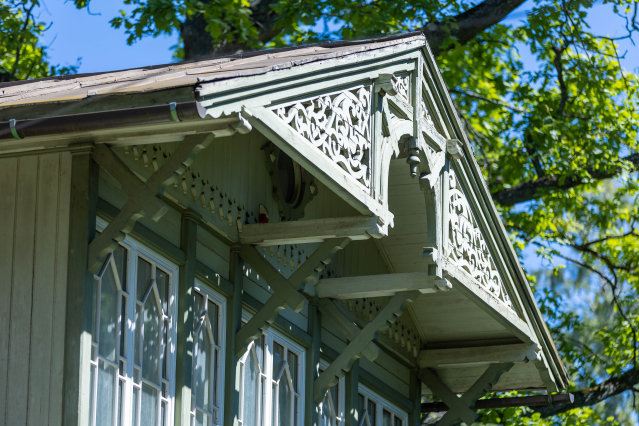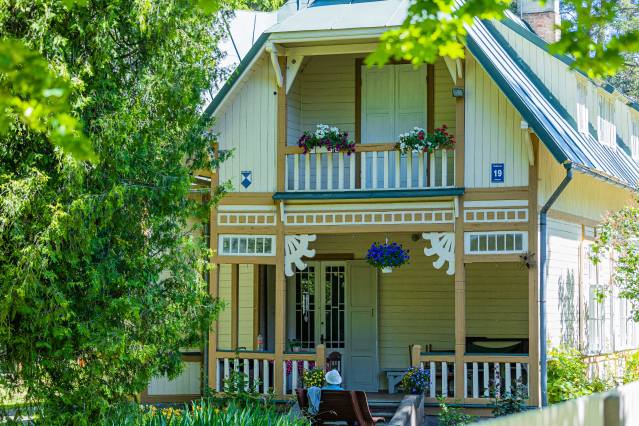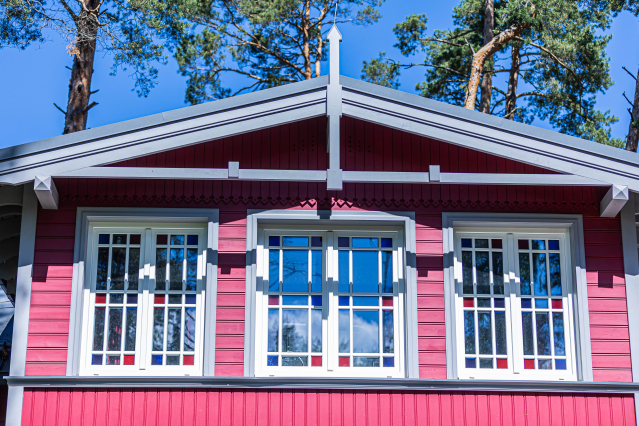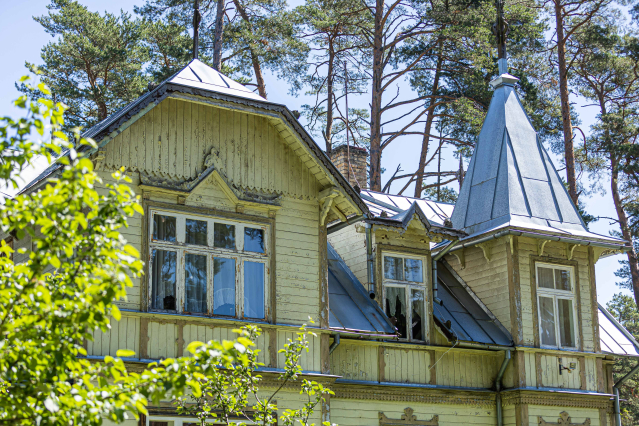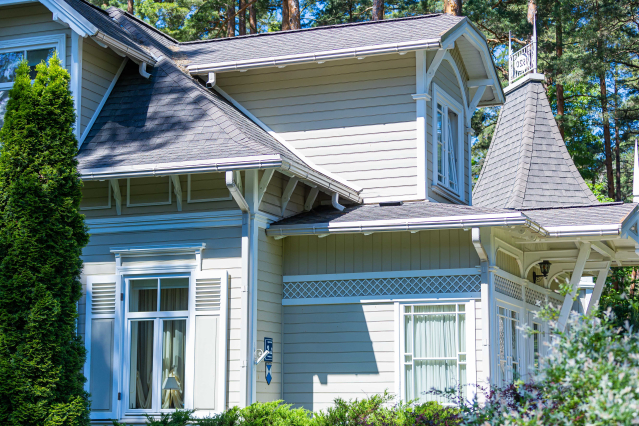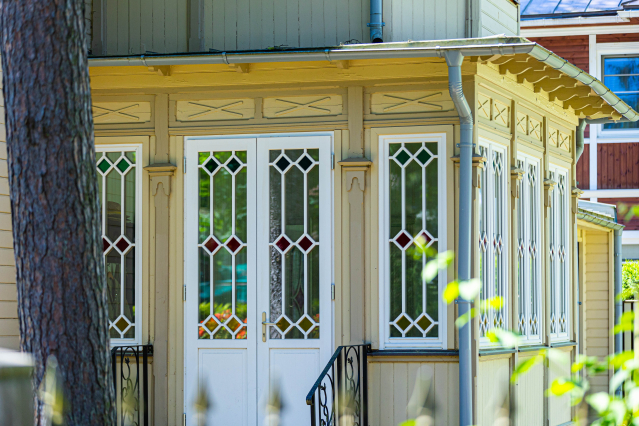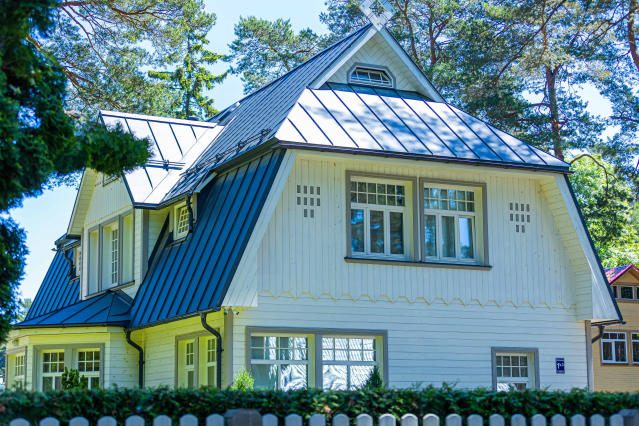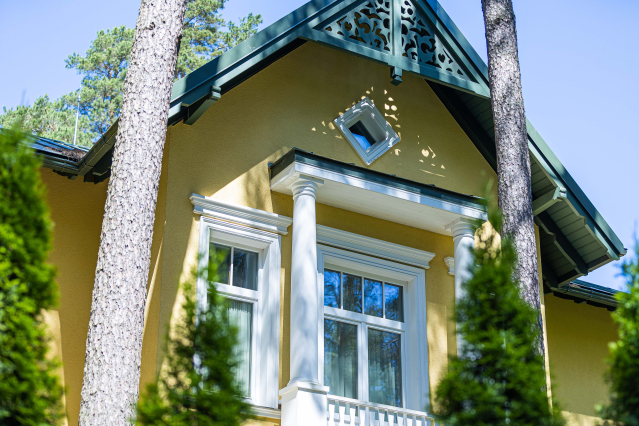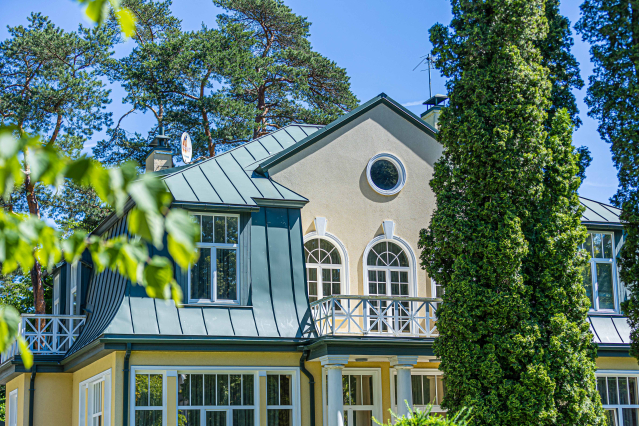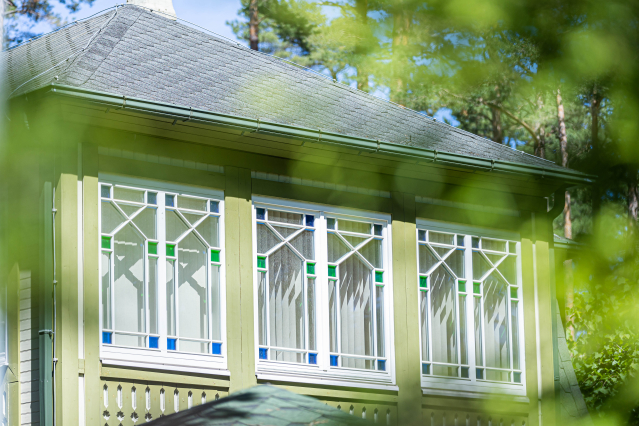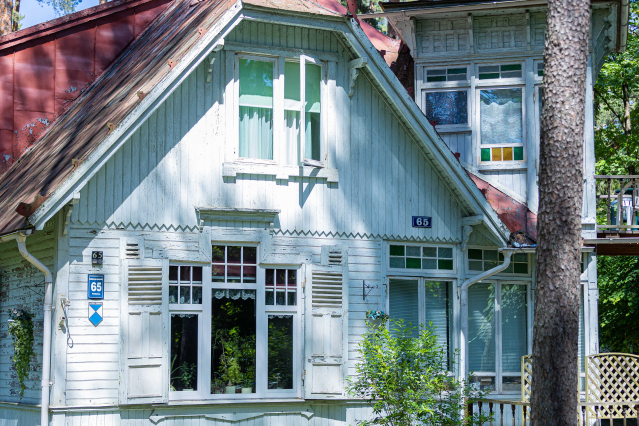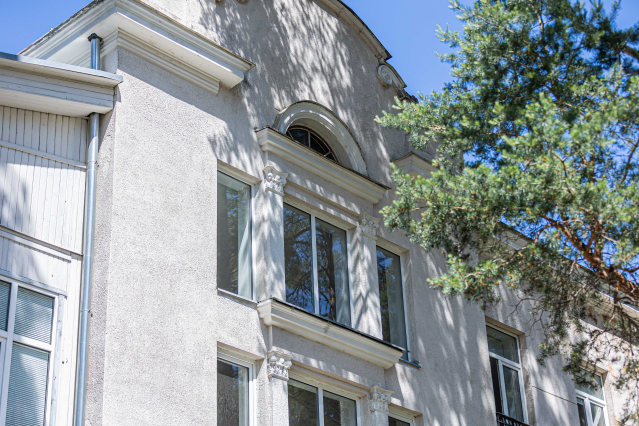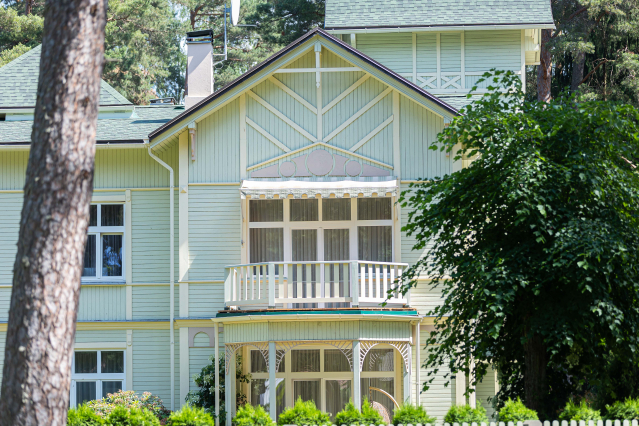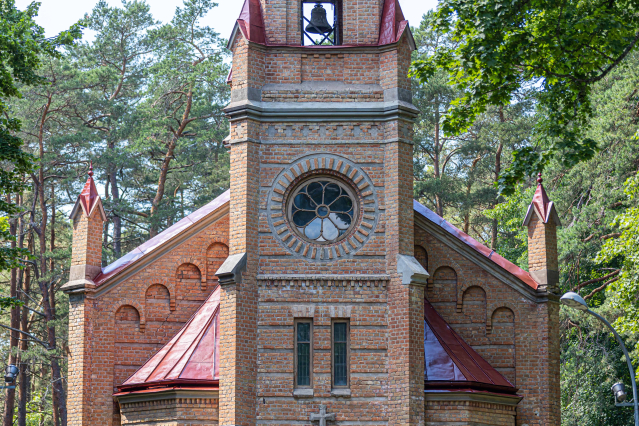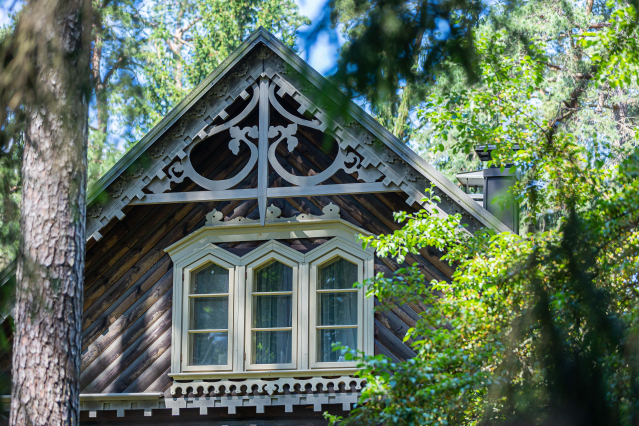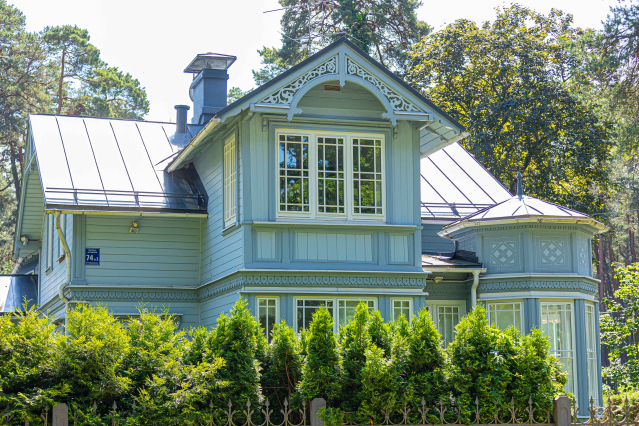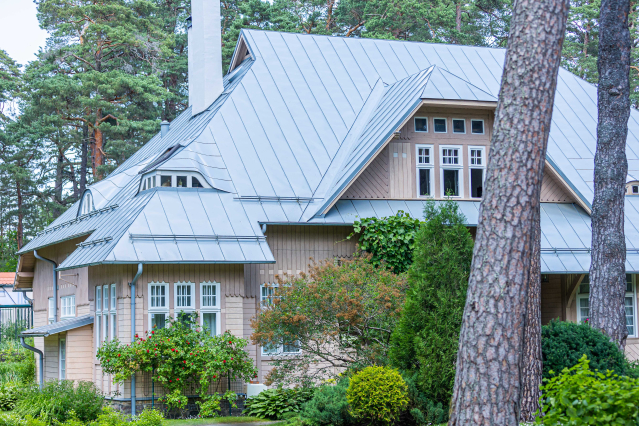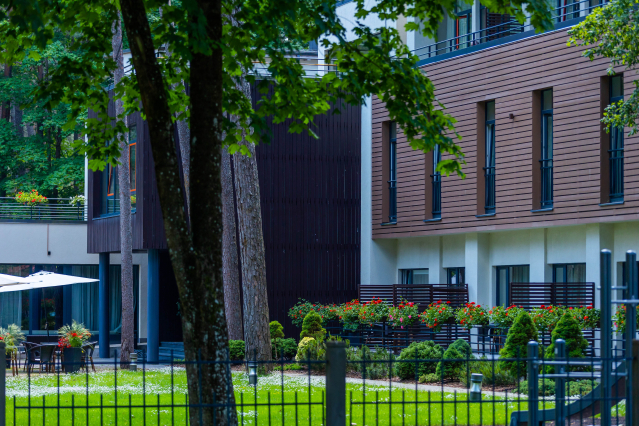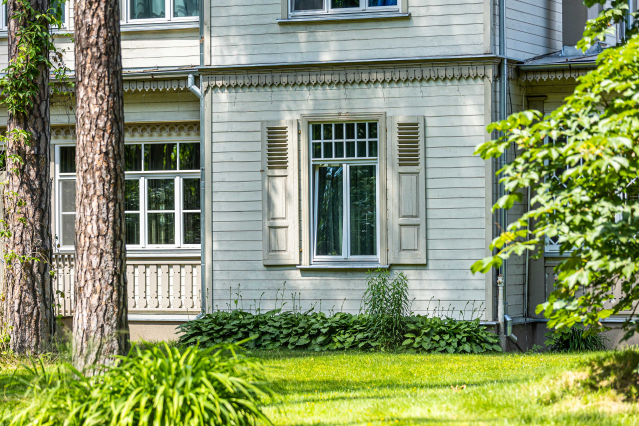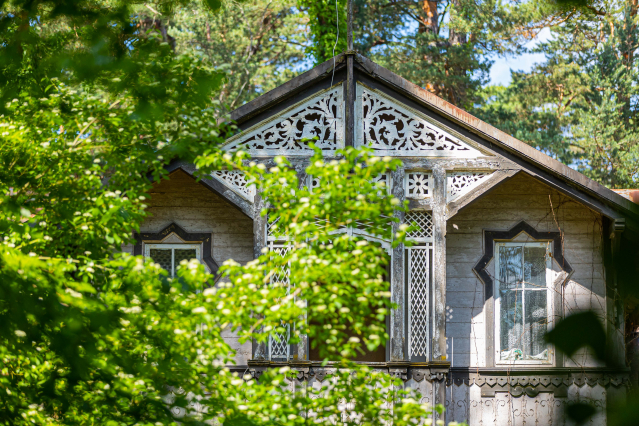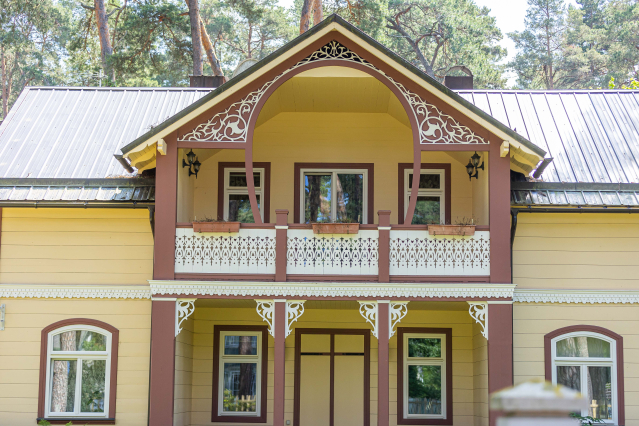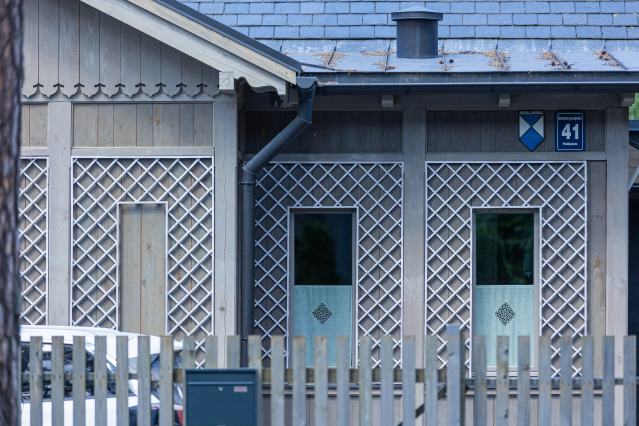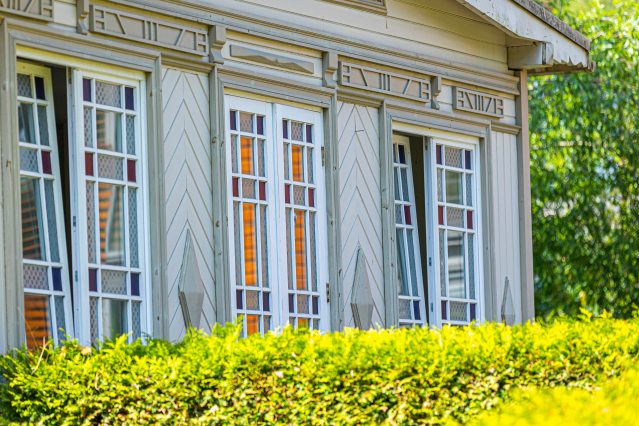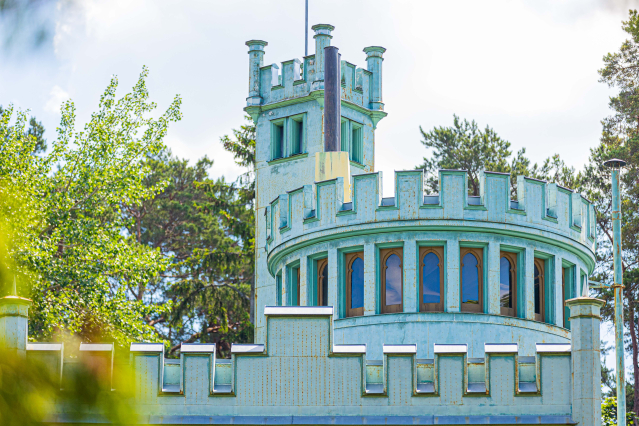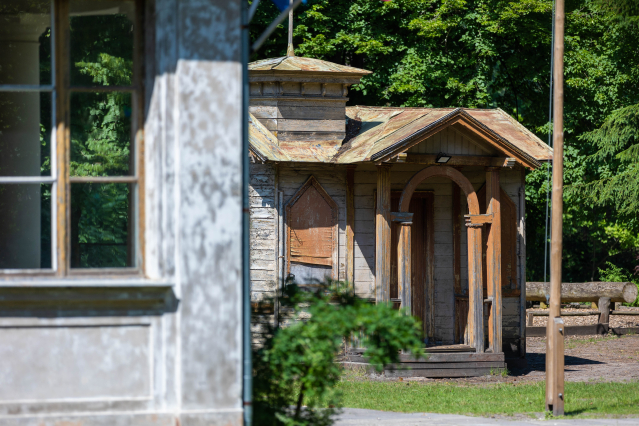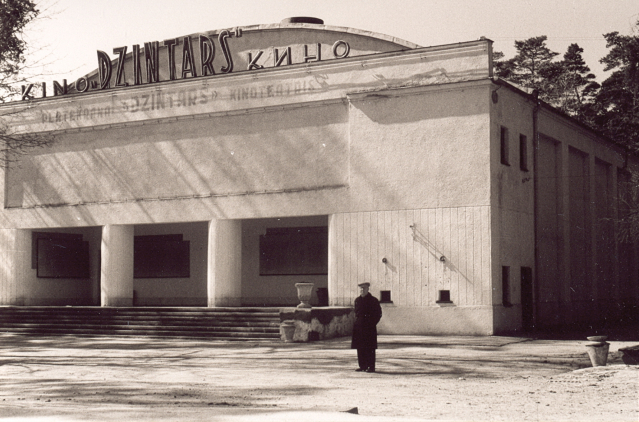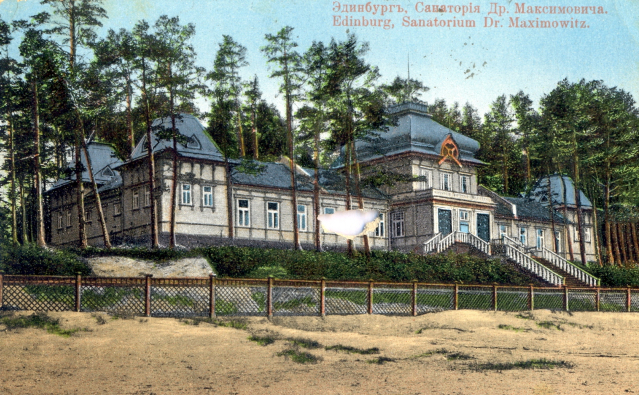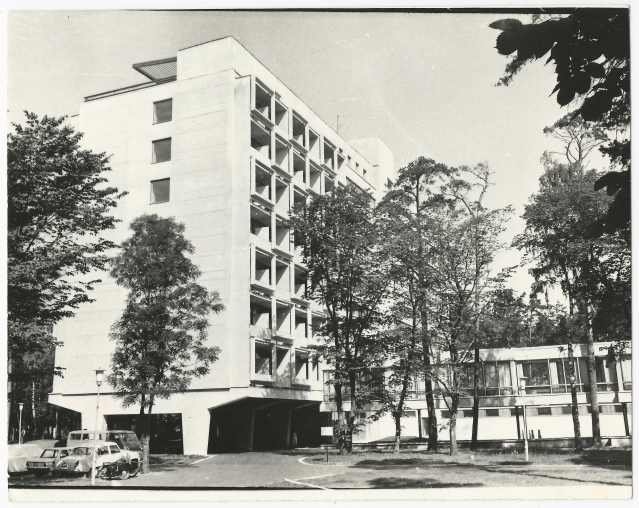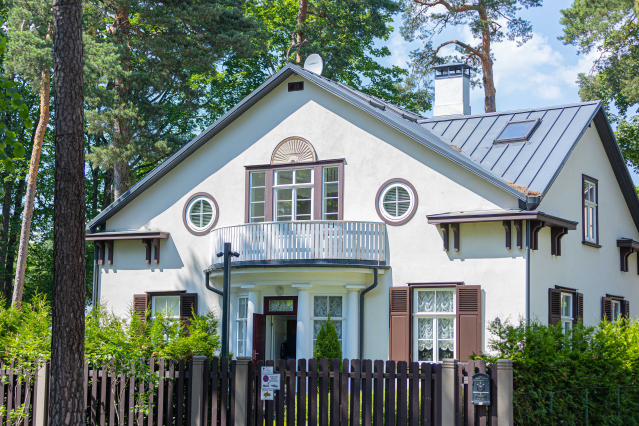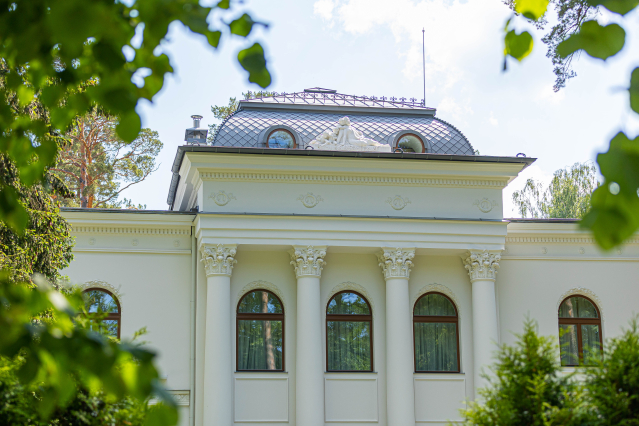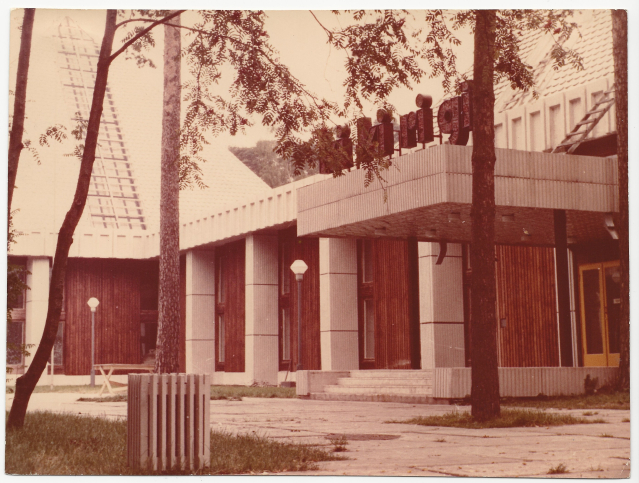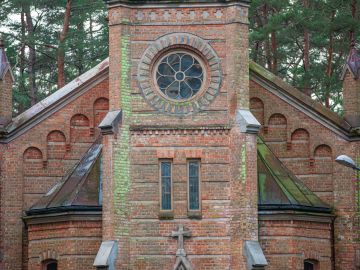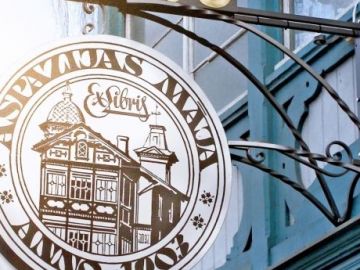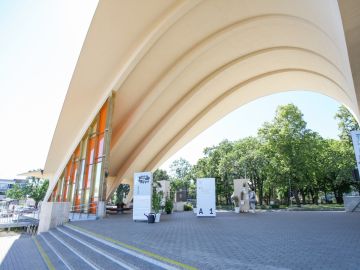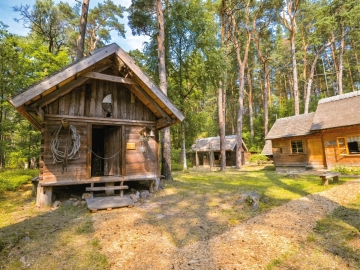Dzintari. Aristocratic Edinburgh
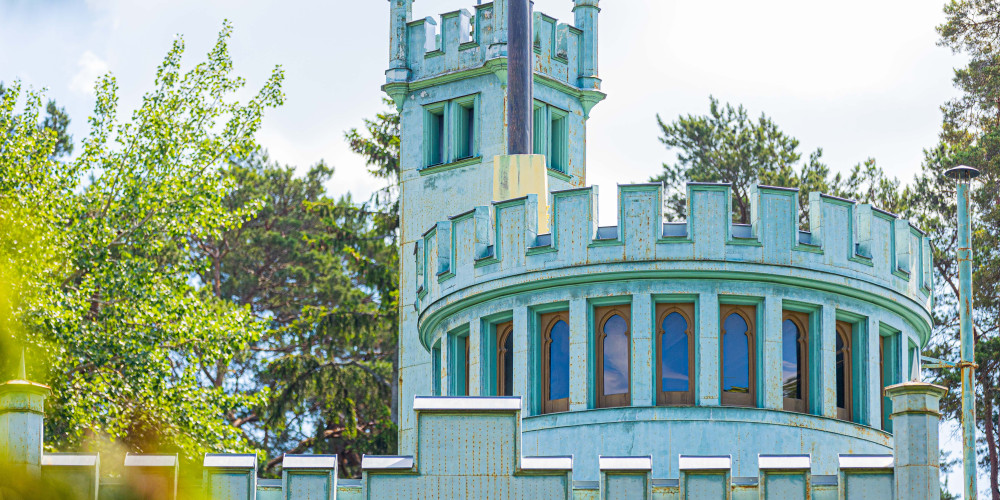
Dzintari is one of the parts of the city of Jūrmala, In 1874, in honor of the marriage of Maria, the daughter of the Russian Emperor Alexander II, with Alfred, the Duke of Edinburgh, the son of Queen Victoria of Great Britain, the colony of cottages established in the forest area of the Bulduri manor gained the name of Edinburgh. At the time, when the neighboring lands of Majorenhoff (now – Majori) rapidly developed as a place of trade and pleasure in the 1870s, Edinburgh was formed as a place of residence for wealthy Rīga residents and vacationing aristocrats with magnificent summer houses and villas. Summer was celebrated in Edinburgh, enjoying walks on the beach, swimming, playing tennis, visiting both "bathhouses" and concerts, hosting friends and acquaintances. Along with the opening of the Rīga-Tukums railway line in 1877, a railway station was also established in Edinburgh. In 1878, a stage was built for holding concerts. Since 1897, various theater troupes and musical orchestras regularly performed here. Edinburgh earned the fame of the most aristocratic bathing spots in Jūrmala. After the establishment of the Republic of Latvia in 1920, Edinburgh was included in the newly created city of Rīgas Jūrmala. At this time, Edinburgh, which had developed into a prestigious mansion district for the wealthiest summer residents, also began to build typical family houses, which used the classical forms popular in Jūrmala and the architectural details of national romanticism. In 1922 Edinburgh was renamed Dzintari.
Open in PDF format...
1. Railway station "Dzintari"
The current building of the railway station "Dzintari" was built in 1980. In the twists and turns of history, the station has undergone several name and location changes. The station "Edinburga" was opened at the same time as the railway line Riga-Tukums was opened in 1877. In 1907, the station was renamed "Edinburga II", because, as the number of residents and vacationers increased, an additional stop "Edinburga I" was built between it and Bulduri railway station. In 1929 "Edinburga I" was renamed "Avoti", and "Edinburga II" - "Dzintari". In 1964, when the "Avoti" stop was eliminated, the "Dzintari" station building was moved, where it is still located today - at Edinburgas Prospekts 2. In 2015, elevated platforms were built at the "Dzintari" railway station, and the station building was reconstructed.
2. Edinburgas prospekts (until 1960 – Kara iela, from 1961 to 1990 – Gagarina prospekts)
The construction along the avenue was formed at the end of the 19th century. The plots of land here were smaller and mainly rented cottages and boarding houses were built. Many buildings have been awarded different conservation statuses. Buildings with the status of "Architectural monument" must be preserved through renovation or restoration. The next level of protection - "Building of cultural and historical value" - obliges its owner to preserve the volume, style, characteristic building elements and construction materials when rebuilding the building. Buildings with the status "Historical background building" must preserve their size and style, but rebuilding or documented demolition is also allowed.
3. Edinburgas prospekts 25
The building was built in 1930 as a residential house. The building is an object of historical background construction. In the 21st century, its architecture was supplemented with modern glazing, preserving the historical scope.
4. Edinburgas prospekts 31/33
Until the 80s of the 20th century, the republican children's hospital "Avoti" was located here, which specialized in the rehabilitation of children after respiratory system, gastrointestinal tract, orthopedic and other diseases. Currently, the plot is undeveloped.
5. Edinburgas prospekts 35 (lit. 1)
The building was built in 1925 as a residential house. It has the luxurious wood-carved decorations characteristic of Jūrmala's historical wooden buildings. An architectural monument of local importance.
6. Intersection of Edinburgas prospekts and Piestātnes iela
There used to be a railway station "Avoti" opposite Piestātnes iela - an additional station between Dzintari and Bulduri. The station was removed in 1964. Luxurious villas and guesthouses lined both sides of the street. The summer house of the prominent Latvian diplomats and intellectuals Groswald family was also located here.
7. Piestātnes iela 21
A classic Jūrmala summer house with a polygonal tower construction and luxurious wood carvings. The asymmetric composition of the wooden building shows the influence of Art Nouveau and the fact that the summer house in its current form has been standing on this plot of land in what was then Edinburgh since the 20th century. at first. In the interwar period, in the 1930s, when this district was called Avoti, visitors were received here by a doctor specializing in nervous diseases and speech defects.
8. Piestātnes iela 19
The building is an architectural monument of national importance and charms with its details and naturalness made by craftsmen more than a hundred years ago. The building is currently managed by its historical heirs. The owner's great-grandfather, a master potter, bought the plot of land - now Piestātnes iela 19 and 19A - from the Bulduri estate. The stories say that for a thousand gold tsar's rubles... The owner's family lived on the adjacent plot of land at Piestātnes iela 19A, but this house was built as a summer house for rent. When the family got the property back in 1994, the slate roof that had been installed during the Soviet era was leaking, the windows were broken, the tiles were broken. In Soviet times, the tenement house had turned into a military commissariat summer house. Slowly, restoration works have started in the family property. First the roof is put on, then the facade is painted. In 2023, the owners of the building received the Jūrmala historical architecture award for one of the most qualitative renovations of a historical building.
9. Piestātnes iela 19A
Historic wooden summerhouse built at the beginning of the 20th century. An architectural monument of national importance. The building's mezzanine with a loggia and a covered porch is artistically significant. Their bays are decorated with lattice motifs.
10. Former recreation house of the railway workers
On the opposite side of Piestātnes iela, there used to be a boarding house of the Ministry of Transport of the USSR, built in 1965, where railway employees and their families rested. In 2022, the buildings were rebuilt into a modern apartment complex.
11. Edinburgas prospekts 39, k.1
The building was built in 1910 as a residential house. The main facade is accented with a single-story veranda built into the mezzanine. The house was renovated in 2019-2022. year. After the renovation, the house has acquired an expressive tone, thus bringing a modern accent to the traditional building.
12. Aglonas iela 1
The building was built in 1910. An architectural monument of local importance.
13. Aglonas iela 2, lit.2
The building with the picturesque asymmetric tower characteristic of Art Nouveau wooden construction was built at the beginning of the 20th century as a residential house. An architectural monument of local importance. Renovated in 2004-2007.
14. Edinburgas prospekts 47, lit.1
The building was built in 1920 as a summer house. An architectural monument of national importance. It features interesting glazed verandas on both sides of the two-story house and ornate wood carvings on the roof overhang.
15. Krāslavas iela 1, k.3, "Villa Pehkschen"
A vivid example of national romanticism. A compact wooden building with a mansard roof, it was historically called "Villa Pehkschen" in honor of its architect - Konstantin Pehkschen. Stylized motifs of ethnographic ornaments can be seen in the system of decorative elements (roof eaves, double cross motif in the design of the columns). The building was renovated in 2013-2014.
Konstantīns Pēkšēns (1859–1928) is one of the most prominent Latvian architects of all time. Until the First World War, many young Latvian architects, who later became famous, worked in the Pēkšēns’ workshop - Eižens Laube, Aleksandrs Vanags, Ernests Pole, Augusts Malves. More than 250 stone and wooden buildings have been built in Rīga, including expressive rental houses in the center of Rīga and the house at Alberta iela 12, where the Art Nouveau Museum is currently located.
16. Krāslavas iela 2
A wooden house built in the early 20th century in the style of Jūrmala's traditional architecture. During the Soviet era, the building of the rest house "Dzintari". The building was rebuilt in 2000 and 2005.
17. Edinburgas prospekts 53
The building was built in 1926 as a residential house. During the Soviet period until 1993 – one of the buildings of the rheumatic cardiology rehabilitation centre "Bulduri" for children. Children with cardiovascular diseases, rheumatism, and chronic inflammation of the upper respiratory system were treated here. The centre could accommodate 200 children at the same time, and it was the largest sanatorium of its type in Latvia. In 1994, the rehabilitation of children was transferred to the national rehabilitation center "Vaivari" and other regional centers, while the sanatorium was transformed into the "Bulduri" family care center. The center housed children from poor and socially disadvantaged families, orphaned children from various Latvian cities. In 2006, the center was closed. Now the buildings have been renovated and are privately owned.
18. Ludzas iela 3
The building was erected at the beginning of the 20th century. It has a classic symmetrical volume with a mansard roof construction and a four-column portico at the entrance, semi-circular window bays, original shutters, bay window construction. It is an architectural monument of local importance. In 1999, the building was renovated.
19. Edinburgas prospekts 61
There are two buildings on the plot, which were built in 1928 as residential houses. During the Soviet era, a recreation home was established here. In 1996, the plot of land with buildings was recovered by its historical owners. They donated the property to the Border Guard of the Republic of Latvia, and for some time the Lielupe port border control point and the Immigration Service were located there. In 2007, the buildings were renovated. Now the "Jūrmala" point of the Rīga Administration of the State Border Guard is located here.
20. Edinburgas prospekts 65
The building was erected in 1909 and, as its picturesque, asymmetrical size shows, it is an expressive example of Art Nouveau wooden construction. An architectural monument of local importance.
21. Edinburgas prospekts 75
One of the rare examples of so-called Stalinist architecture (also known as Stalin's baroque or Stalin's ampere) in Jūrmala. The building was erected in 1959 as one of the buildings of the "Bulduri" sanatorium with 125 places. The monumental composition of the building is made visually a little lighter by the wooden gallery on the terrace of the second floor. Currently, the building belongs to the State of Latvia, and it houses the Jūrmala branch of the State Land Service and the Urban Planning Department of the Jūrmala City Administration.
22. Krišjāņa Barona iela 13
A residential building built at the beginning of the 20th century. A two-story wooden frame construction of asymmetrical composition, the volume of the building is accentuated by a three-story tower in the southeast. The facade decoration uses a unique combination of silhouette cut details, created under the influence of Art Nouveau. An architectural monument of local importance. In 2017, the residential building was restored.
23. Krišjāņa Barona iela 6, Bulduri Evangelical Lutheran Church
As the number of residents and resort guests in Bulduri grew, the need for a church in the premices arose. The church was built and consecrated in 1889, based on the project of the architect Herman Hilbig. The red-brick church was once known as the Waldkapelle or Forest Chapel. Services were held here in German, Latvian and Estonian languages. In 1930 the congregation began the necessary repairs to the church: repaired the roof, installed electricity and installed heating so that services could be held in winter as well. After the Second World War, the film document department of the Central State Film and Photographic Document Archive was located in the building, completely destroying the interior. At the end of the 90s, the church was returned to the congregation, and now services are held here again.
24. Krišjāņa Barona iela 4
An architectural monument of local importance. A one-story log house with a roof floor and an extension on the west facade. The building's architectural form and decorative details show that it belongs to the Russian national romanticism rarely represented in Latvia. There is a version that the building was moved to its current location from Dzintari, where it was located next to the then Edinburgh Orthodox Church. It is assumed that the building was built around 1894 - at the same time as the church. In the 60s of the 20th century, the ranger of the Bulduri district lived here. The building was renovated in 2014-2018.
25. Dzintaru prospekts (formerly - Edinburgas prospekts)
Built at the end of the 19th century, continuing the regular planning started in Bulduri district with straight streets and plots of equal size. At first, cross streets were called lines and numbered. Starting from the end of the 19th century, wealthy, educated people of German, Russian and Latvian origin began to buy plots of land and build summer houses designed by famous architects. There are fourteen architectural monuments of national and local importance in Dzintaru prospekts.
26. Dzintaru prospekts 74, lit. 3
The building was erected at the beginning of the 20th century as a residential house, and it has a rich set of features characteristic of the traditional construction of Jurmala. An architectural monument of local importance. In 2000, the house was renovated, preserving the entire decorative system and elements of the building.
27. Dzintaru prospekts 53
The residential house built in 1909 by the architect Wilhelm Bokslaff is an expressive example of national romanticism inspired by Art Nouveau. An architectural monument of national importance. Now the owners live here, who have carefully renovated the historical property - both the residential house, the basement, and the farm building, where the driver and the gardener once lived.
Wilhelm Ludwig Nikolai Bokslaff (1858–1945) is one of the most outstanding architects of the first half of the 20th century. Born in Rīga in an old, rich and aristocratic family. He studied at the Rīga Polytechnic University, where he received the education of an architect. In 1901, according to his project, the Jaunmoku Palace owned by George Armitstead was built, 1902-1905. designed one of his best-known buildings - the building of the Rīga Stock Exchange Commercial School (now the building of the Latvian Art Academy) in the "brick Gothic" style. In 1907 – 1909 the Dubulti Lutheran Church in Jūrmala was built according to his design. V. Bokslafs is the author of several industrial projects - including the water towers in Riga – in Āģenskalns (1910) and Čiekurkalns (1912), as well as the housings of the Sloka Paper Factory in Jūrmala.
28. Dzintaru prospekts 68
In the place where you can see the modern hotel "Amber Sea Hotel" with a restaurant and a small water relaxation center, during the Soviet times there was one of the blocks of the sanatorium named after Maxim Gorky, later, in the 90s, a hotel.
29. Dzintaru prospekts 51
The building was erected at the turn of the 19th and 20th centuries. A pictorial composition of volumes with original decor elements, interior and exterior details. In the 90s of the last century, the Jūrmala Alternative School operated here.
30. Dzintaru prospekts 49
The one-story building, richly decorated with wood carving details, is an architectural monument of national importance from the beginning of the 20th century. The balcony under the overhang of the mezzanine stands out in particular. A small veranda facing the yard. From the cross street you can see a decorative farm and gate alleys. The building is owned by the state.
31. Dzintaru prospekts 58
An architectural monument of national importance from the end of the 19th century. One of the most expressive turn-of-the-century wooden summerhouses, decorated with wooden carvings. The decor of the open veranda of the street facade is exceptionally rich - wood carvings, a semi-circular niche on the roof floor, horizontal decorative strips.. Initially, the building was built as a summer house for one family, during the Soviet period it was rebuilt for use by several families. Noting the high-quality reconstruction of the building, the building was nominated for the Jūrmala Historical Architecture Award in 2024.
32. Dzintaru prospekts 41
The buildings are a monument of national importance and one of the rare examples of construction of fishermen's houses in Jūrmala, where the entire historical substance has been used in the renovation. The reconstruction of the building won the 1st prize in the Jurmala Historical Architecture Award in 2023. The building, built in 1910, is evidence that Jurmala, including the part of the city where elegant villas and guesthouses have been lined for more than a century, was once a simple fishing village. Today, it is hard to imagine that fishing boats and nets were visible all along the sea coast, herring drying houses stood in the dune forest, and the construction consisted of heavy plank buildings. The building is a typical example of such an evolution. The fishermen's houses - the main building and the outbuilding with the summer kitchen - have 7.5 cm thick wooden plank walls. Over time, the buildings have been functionally and visually adapted to the needs of summer residents. A fine-grained veranda has been built for the holiday home, while the open porch is decorated with wooden slats. The arrangement of diagonal grids is the oldest method of decorative design of open columns. The delicate wooden grid on the restrained facade facing the street, painted with linseed oil colors, still acts as an expressive accent today.
33. Dzintaru prospekts 39
Until the World War I, the boarding house of Helen Kevich operated here, but in 1930, the "Edinburg" sanatorium was opened, about which the brochure of that time says: "The sanatorium is modernly furnished with all amenities, located in a beautiful place in the forest, close to the sea. Sunny lounges. Suitable for rest and health improvement for those who have suffered from the disease, as well as for the treatment of various internal and nervous diseases. Medicinal baths and dietary supervision, exercise, massage, electric massage, diathermy, mountain sun, sollux sun, beauty care. First-class cuisine and service." During the Soviet era, the building was granted the status of a cultural and historical monument, because in 1905, the Soviet writer Maxim Gorky stayed here. Later there was one of the corps of the sanatorium named after M. Gorky. In total, the sanatorium, whose profile was the treatment of diseases of the cardiovascular system, had 425 places, located in several buildings. A copy of the historical building was built in 2006; now the building is part of a summer house complex.
34. Dzintaru prospekts 52/54, Morberg’s summer house and botanical garden
The unique building in Neogothic style is an architectural and cultural monument of the national importance. It was built in 1880-1883 by the notable Latvian patron, construction contractor Kristaps Morbergs. The cottage and the garden were built in an undeveloped pine forest at the time. Morbergs used construction materials left over from the construction of other buildings he designed, but he used a layer of pine needles to insulate the walls. The wooden summerhouse is sheathed with metal plates, probably the oldest window glass in Latvia can be seen in the windows. Once upon a time, the pride of the garden was a pool decorated with a sculpture – a boy with a swan – but it has disappeared over time. Now the pool is replaced by a rose bed. The cellar created in the corner of the plot may once have been used for the cultivation of champignons. In Soviet times, the popular "Balsam bar" operated there. During the Soviet era, the library of the sanatorium named after Maxim Gorky was established here. In the 1970s, a dormitory was built from bricks instead of a greenhouse and an orchard. According to Kristaps Morberg's will, the complex belongs to the University of Latvia. In 2008, the University of Latvia restored the summer house complex - summer house, conservatory, wine cellar, utility building, caretaker's and manager's house - according to the project of architect Pēteris Blūms. Inside you can see the magnificent interior of the building, including Albert Hogarth's ceiling painting from 1893, hand-drawn wallpaper restored after old models, original doors and pot stoves. This is one of the most outstanding restoration works in Latvia.
35. Drustu iela, exit by the sea
Here you can rest on a bench and then continue your walk along the beach, skipping some sights, or return to the city streets. In 1978, the ice cream cafe "Leduspuķe"(“Ice Flower”) was opened here with an original interior - the hall was designed in blue and white tones and decorated with stylized ice cubes. Cakes, coffee and refreshing drinks were offered to visitors, but the most popular were various ice cream cocktails and ice cream "Leduspuķīte". Now the cafe building is gone.
36. Dzintaru prospekts 27
Both the building and the unique gazebo, which resembles a doll's house, are architectural monuments of the beginning of the 20th century. In the 1970s and 1980s, there was a kindergarten here. Currently, the building belongs to the state and the kindergarten of the Jurmala Alternative School operates here.
37. Dzintaru prospekts 19
In 1958, the cinema "Dzintars" with 800 seats was opened here. Later, the filming pavilion was established here. Currently, only the structures of the building remained.
38. Smiltenes iela 3, ex. Dr M. Maksimovičs water healing centre
The building is best viewed from the beach side. It is an architectural monument of the national importance and one of the few historical beachside resort building that still can be seen nowadays. It was built in 1906 as a sanatorium for doctor Mihail Maksimovich (1867–1923). It is built on top of a dune in a symmetrical volume composition. In the center there is a tower-like two-story volume, and on the sides - two smaller structures with turrets. The entire ensemble is connected by a bath building. Neo-Russian style dominates the sea side facade, Art Nouveau details are also visible. One of the most impressive early 20th century wooden buildings in Jūrmala.
The spa and sanatorium quickly gained positive fame, increasing the popularity of Rīgas Jūrmala as a resort. This was the first sanatorium in Rīgas Jūrmala, which worked all year round. The water healing center offered sea water, sulfur water and mud baths, massages, exercise classes, Charcot showers, electric treatments. In 1913, doctor Maksimovičs established the Rīgas Jūrmala Society of Doctors, the purpose of which was to study the effects of seaside healing factors on the human body, contributing to the development of the Rīgas Jūrmala resort. After the death of M. Maksimović in 1923, the sanatorium continued its operation under the name "Edinburgh". After the Second World War, several wooden buildings were used for the construction of the "Baltija" sanatorium. Currently, the remaining buildings are privately owned.
39. Dzintaru prospekts 11, ex. Sanatorium “Baltija”.
In recent times, the sanatorium "Baltija" operated here, profiling in the treatment of diseases of the digestive organs and metabolic disorders. Up to 400 people could stay here at the same time. Scientific work was also carried out in the sanatorium, researching new treatment methods with the application of mineral water bath, therapeutic mud and drinking mineral water. The beginnings of the institution can be traced back to 1945, when the gastroenterology sanatorium "Baltija" was established in several buildings of the former M. Maksimovičs ‘s sanatorium complex nearby. In the 70s of the 20th century, a multi-storey building was built here, the architectural solution of which was considered very modern and successful at that time. The remains of the mineral water pavilion of the "Baltija" sanatorium still can be seen nearby. In 1959, a 400-meter deep well was dug in the territory of the sanatorium. Natural drinking mineral water "Baltija" containing chlorides, sulfates and sodium flowed out of it. A pavilion was created next to the sanatorium building, where vacationers could drink this healing water. Its composition was similar to Ķemeri mineral water, and it was used in the treatment of stomach and intestinal diseases. The remains of the former sanatorium "Baltija" building still can be seen here. The first floor level of the once modern building was built on reinforced concrete pillars, which allowed the use of glazing in the decoration of the hall and entrance. Next to the multi-storey residential building there was a three-storey building, on the first floor of which there was a billiard room and a library, on the second floor - a canteen with a summer terrace, on the third floor - a dance hall and a concert hall. The two buildings were connected by a gallery. The three-story building, as well as the pool building, have not survived to this day. In 1988, the sanatorium building was renovated, but it was closed at the end of the 1990s. Currently, the territory with the abandoned building is privately owned.
40. Dzintaru prospekts 3, lit.1
The property was built in 1930 according to one of the typical projects of family houses of that time with details of national romanticism. It represents an architectural monument of national importance. Three almost identical houses were built on one plot of land, which could be called the "Three Brothers" of Jūrmala.
41. Dzintaru prospekts 18
The building, which is an architectural monument, was built in 1929 according to the project of Eižens Laube, a prominent Latvian architect. The plasticity of the building's volumes is close to the neoclassical style - with a rich motif of classical order elements. The floral motifs used in the decoration of the facades create a luxurious impression.This beautiful house was built for businessman Georgs Rudzītis, who owned a cabbage processing factory in Rīga. The company, which was founded by his father in 1863, grew into a famous large-scale industry, whose products were awarded with 18 medals. Rudzītis was an active social worker, worked in several organizations, was a big patron, for which he was awarded the Order of Three Stars. The businessman died in 1934. After his death, opera singer Milda Langenfelde - the daughter of Georgs Rudzītis's wife - became the owner of the house. In 1940, the property was nationalized. In the 70s of the 20th century, the Department of Pregnancy Pathology of Jurmala City Hospital was opened here. At that time it was one of the few institutions of this type in the USSR, it was called the "White House of Hope". The institution had a semi-sanatorium regime - peace, walks along the sea, treatment, full nutrition. When Latvia regained its independence, the house was recovered by the heirs, but after a short time it was sold. Currently, the building is privately owned.
Eižens Laube (1880–1967) is Latvia's most prominent architect of the first half of the 20th century, who, with his projects and publications, strengthened the trend of national romanticism of the Art Nouveau style, but due to changes in architectural style, became the leading architect of Latvia in the interwar period and created brilliant neoeclectic buildings and interiors. There are many buildings designed by Eižens Laube in Jūrmala.
42. Dzintari forest park (Dzintaru mežaparks)
One of the newest and most popular recreation spots in Jūrmala opened to visitors in 2008. In Dzintari forest park, unique natural values - 200-year-old pines and the protected biotope - bluebirds, coexist harmoniously with stylish architecture. The park’s project has been nominated for the prestigious Mies Van Der Rohe modern architecture award, evaluated at the annual exhibition of the Latvian Architects' Union and participated in the European Landscape Architecture Biennale. Children's playgrounds, skating ramps and shopping pavilions are arranged in the park's 13 hectares, to which boardwalks and bridges lead. Everything - from the signs to the trash cans - fits into the overall design handwriting. As the critic has aptly noted: "mastering nature, not transforming it, but making it more convenient."
Adventure parks "Tarzāns" and "Tīklu Parks" have been operating here in the summer seasons for several years.
The central object of the park is the 33-meter-high observation tower designed by Arnis Kleinbergs (ARHIS office), which is comparable in slenderness and height to the Jurmala pines. The 203 steps of the open structure lead to the viewing platform at a height of 33.5 m. The 12 balconies built in the facades of the tower, on the way to the top, open up a view of all four sides of the sky.
Before that, in 1976, the game and amusement palace "Daile" was built here according to the project of the architect Edgars Šēnbergs, which was one of the most important buildings of modern architecture both in the context of Jūrmala and Latvia. The "Daile" was a place where concerts, conferences, spa science exhibitions were held, and a bowling alley was set up there. In one wing of the recreation complex, there was a children's cafe "Ki-ke-ri-gi". Especially for this purpose, an interior corresponding to the children's theme was created: wooden chairs with high backs with wood carvings that resemble fairy-tale thrones, dishes with drawings of fairy-tale characters, wall paintings and stained-glass windows. At the entrance, guests were greeted by a dwarf in a funny hat, while the central character of the cafe - a rooster - stood and moved his head. On the menu - food and drinks according to specially developed recipes: "Forest stump", "Golden nuts", "Magic wands", "Snow White's Treat". On Sundays, puppet theater actors entertained the visitors, and at the end of the year, New Year's entertainment programs were held. Amusement park "Lunaparks" with carousels, gaming machines, a children's autodrome and a Ferris wheel operated every summer on the park's territory. In 2002, the "Daile" building was demolished.
